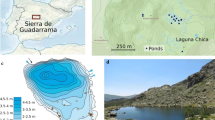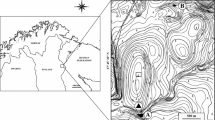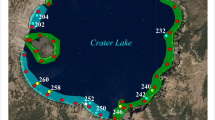Abstract
Fish introduction is a major threat to alpine lake biota leading to the loss of native species and to the degeneration of natural food-webs. This study provides an extensive investigation on the impact of the introduced fish Salvelinus fontinalis on the native communities of alpine lakes in the Gran Paradiso National Park. We compared the macroinvertebrate and zooplankton communities of six stocked and nine fishless lakes with a repeated sampling approach during the summers 2006–2009. The impact of fish presence on alpine lake fauna is often mediated by the strong seasonality governing these ecosystems, and it dramatically affects the faunal assemblage of littoral macroinvertebrates and the size, structure, and composition of the pelagic zooplankton community with a strong selective predation of the more visible taxa. Direct ecological impacts include a decrease or extinction of non-burrower macroinvertebrates and of large zooplankton species, while small zooplankton species and burrower macroinvertebrates were indirectly advantaged by fish presence. Due to the existence of a compensation between rotifers and crustaceans, fish presence does not affect total zooplankton biomass and diversity even if fish are a factor of ecological exclusion for large crustaceans. These compensatory mechanisms are a key process surrounding the impact of introduced fish in alpine lakes.





Similar content being viewed by others
References
Arnott, S. E., N. D. Yan, J. J. Magnuson & T. M. Frost, 1999. Interannual variability and species turnover of zooplankton in Shield lakes. Canadian Journal of Fishery and Aquatic Sciences 56: 162–172.
Baayen, R. H., D. J. Davidson & D. M. Bates, 2008. Mixed-effects modeling with crossed random effects for subjects and items. Journal of Memory and Language 59: 390–412.
Bahls, P. F., 1992. The status of fish population and management of high mountain lakes in western United States. Northwest Science 66: 183–193.
Bradford, D. F., S. D. C. Cooper, T. M. Jenkins, K. Kratz, O. Sarnelle & A. D. Brown, 1998. Influences of natural acidity and introduced fish on faunal assemblages in California alpine lakes. Canadian Journal of Fishery and Aquatic Sciences 55: 2478–2491.
Brancelj, A., 1999. The extinction of Arctodiaptomus alpinus (Copepoda) following the introduction of char into a small alpine lake Dvojno Jezero (NW Slovenia). Aquatic Ecology 33: 355–361.
Brooks, J. & S. I. Dodson, 1965. Predation, body size and composition of plankton. Science 150: 28–35.
Brown, J. H. & J. F. Gillooly, 2003. Ecological food webs: high-quality data facilitate theoretical unification. Proceedings of the National Academy of Science 100: 1467–1468.
Carlisle, D. M. & C. P. Hawkins, 1998. Relationships between invertebrate assemblage structure, 2 trout species, and habitat structure in Utah mountain lakes. Journal of the North American Benthological Society 17: 286–300.
Compagnoni, R., G. Elter & B. Lombardo, 1974. Eterogeneità stratigrafica del complesso degli “Gneiss Minuti” nel massiccio cristallino del Gran Paradiso. Memorie della Società Geologica Italiana 13: 227–239.
Dawidowicz, P. & Z. M. Gliwicz, 1983. Food of brook charr in extreme oligotrophic conditions of an alpine lake. Environmental Biology of Fishes 8: 55–60.
De Mendoza, G. & J. Catalan, 2010. Lake macroinvertebrates and the altitudinal environmental gradient in the Pyrenees. Hydrobiologia 648: 51–72.
Donald, D. B., R. D. Vinebrooke, R. S. Anderso, J. Syrgiannis & M. D. Graham, 2001. Recovery of zooplankton assemblages in mountain lakes from the effects of introduced sport fish. Canadian Journal of Fishery and Aquatic Sciences 58: 1822–1830.
Dumont, H. J., I. Van de Velde & S. Dumont, 1975. The dry weight estimate of biomass in a selection of Cladocera, Copepoda and Rotifera from the plankton, periphyton and benthos of continental waters. Oecologia 19: 75–97.
Eby, L. A., W. J. Roach, L. B. Crowder & J. A. Stanford, 2006. Effects of stocking-up freshwater food webs. Trends in Ecology & Evolution 21: 576–584.
Edmondson, W. T. & G. G. Winberg, 1971. A Manual on Methods for the Assessment of Secondary Productivity in fresh Waters. Blackwell Scientific Publications, Oxford, UK.
Epanchin, P. N., R. A. Knapp & S. P. Lawler, 2010. Nonnative trout impact an alpine-nesting bird by altering aquatic-insect subsidies. Ecology 91: 2406–2415.
Fisk, D. L., L. C. Latta, R. A. Knapp & M. E. Pfrender, 2007. Rapid evolution in response to introduced predators I: rates and patterns of morphological and life-history trait divergence. BMC Evolutionary Biology 7: 22.
Gilinsky, E., 1984. The role of fish predation and spatial heterogeneity in determining benthic community structure. Ecology 65: 455–468.
Gliwicz, Z. M. & M. G. Rowan, 1984. Survival of Cyclops abyssorum tatricus (Copepoda, Crustacea) in alpine lakes stocked with planktivorous fish. Limnology and Oceanography 29: 1290–1299.
Hadfield, J. D., 2010. MCMC methods for multi-response generalized linear mixed models: the MCMCglmm R Package. Journal of Statistical Software 33: 1–22.
Hall, D. J., S. T. Threlkeld, C. W. Burns & P. H. Crowley, 1976. The size efficiency hypothesis and the size-structure of zooplankton communities. Annual Review of Ecology Evolution and Systematics 7: 177–208.
Knapp, R. A. & K. R. Matthews, 1998. Eradication of nonnative fish by gill netting from a small mountain lake in California. Restoration Ecology 6: 207–213.
Knapp, R. A. & K. R. Matthews, 2000. Non-native fish introductions and the decline of the mountain yellow-legged frog from within protected areas. Conservation Biology 14: 428–438.
Knapp, R. A., K. R. Matthews & O. Sarnelle, 2001. Resistance and resilience of alpine lake fauna to fish introductions. Ecological Monographs 71: 401–421.
Knapp, R. A., C. P. Hawkins, J. Ladau & J. G. McClory, 2005. Fauna of Yosemite National Park lakes has low resistance but high resilience to fish introductions. Ecological Applications 15: 835–847.
Lacoul, P. & B. Freedman, 2006. Relationships between aquatic plants and environmental factors along a steep Himalayan altitudinal gradient. Aquatic Botany 84: 3–16.
Latta, L. C., J. W. Bakelar, R. A. Knapp & M. E. Pfrender, 2007. Rapid evolution in response to introduced predators II: the contribution of adaptive plasticity. BMC Evolutionary Biology 7: 21.
Leavitt, P. R., D. E. Schindler, A. J. Paul, A. K. Hardie & D. W. Schindler, 1994. Fossil pigment records of phytoplankton in trout-stocked alpine lakes. Canadian Journal of Fishery and Aquatic Sciences 51: 2411–2423.
Locke, A., 1991. Zooplankton responses to acidification: a review of laboratory bioassays. Water, Air, and Soil pollution 60: 135–148.
Macan, T. T., 1965. Predation as a factor in the ecology of waterbugs. Journal of Animal Ecology 34: 691–698.
Magnea, U., R. Sciascia, F. Paparella, R. Tiberti & A. Provenzale, 2013. A model for high-altitude alpine lake ecosystems and the effect of introduced fish. Ecological Modelling 251: 211–220.
Matthews, K. R., R. A. Knapp & K. L. Pope, 2002. Garter snake distribution in high-elevation aquatic ecosystems: is there a link with declining amphibian populations and nonnative trout introductions? Journal of Herpetology 36: 16–22.
Merrit, R. W. & K. W. Cummins, 2007. Trophic relationship of macroinvertebrates. In Hauer, F. R. & G. A. Lamberti (eds), Methods in Stream Ecology. Academic Press, London: 585–609.
Mills, K. H. & D. W. Schlinder, 1986. Biological indicators of lake acidification. Water, Air, and Soil pollution 30: 779–789.
Miró, A. & M. Ventura, 2013. Historical use, fishing management and lake characteristics explain the presence of non-native trout in Pyrenean lakes: implications for conservation. Biological Conservation 167: 17–24.
Murdoch, W. W. & J. Bence, 1987. General predators and unstable prey populations. In Kerfoot, W. C. & A. Sih (eds), Predation: Direct and Indirect Impacts on Aquatic Communities. University Press of New England, Hanover: 17–30.
Pace, M. L. & J. D. Orcutt, 1981. The relative importance of protozoans, rotifers and crustaceans in a freshwater zooplankton community. Limnology and Oceanography 26: 822–830.
Parker, B. R., D. W. Schindler, D. B. Donald & R. S. Anderson, 2001. The effects of stocking and removal of a nonnative salmonid on the plankton of an alpine lake. Ecosystems 4: 334–345.
Pope, K. L., J. Piovia-Scott & S. P. Lawler, 2009. Changes in aquatic insect emergence in response to whole-lake experimental manipulations of introduced trout. Freshwater Biology 54: 982–993.
R Development Core Team, 2010. R: A Language and Environment for Statistical Computing. R Foundation for Statistical Computing. Vienna, Austria. http://www.R-project.org/. Accessed 2 June 2011.
Reissing, M., C. Trichine, C. Queimalinos, E. Balseiro & B. Modenutti, 2006. Impact of fish introduction on planktonic food webs in lakes of the Patagonian Plateau. Biological Conservation 132: 437–447.
Ruttner-Kolisko, A., 1977. Suggestions for biomass calculations of plankton rotifers. Archiv für Hydrobiologie–Beiheft Ergebnisse der Limnologie 8: 71–76.
Sarnelle, O. & R. A. Knapp, 2005. Nutrient recycling by fish versus zooplankton grazing as drivers of the trophic cascade in alpine lakes. Limnology and Oceanography 50: 2032–2042.
Savini, D., A. Occhipinti-Ambrogi, A. Marchini, E. Tricarico, F. Gherardi, S. Olenin & S. Gollasch, 2010. The top 27 animal alien species introduced into Europe for aquaculture and related activities. Journal of Applied Ichthyology 26: 1–7.
Schabetsberger, R., M. Luger, G. Drozdowski & A. Jagsch, 2009. Only the small survive: monitoring long-term changes in the zooplankton community of an alpine lake after fish introduction. Biological Invasions 11: 1335–1345.
Schindler, D. E., R. A. Knapp & P. R. Leavitt, 2001. Alteration of nutrient cycles and algal production resulting from fish introductions into mountain lakes. Ecosystems 4: 308–321.
Shilling, E. G., C. S. Loftin & A. D. Huryn, 2009. Macroinvertebrates as indicators of fish absence in naturally fishless lakes. Freshwater Biology 54: 181–202.
Sierszen, M. E., M. E. McDonald & A. J. Douglas, 2003. Benthos as the basis for arctic lake food webs. Aquatic Ecology 37: 437–445.
Tartari, G. & R. Mosello, 1997. Metodologie analitiche e controlli di qualità nel laboratorio chimico dell’Istituto Italiano di Idrobiologia del Consiglio Nazionale delle Ricerche. Documenta dell’Istituto Italiano di Idrobiologia 60: 1–160.
Tiberti, R., 2011. Morphology and ecology of Daphnia middendorffiana, Fisher 1851 (Crustacea, Daphniidae) from four new populations in the Alps. Journal of Limnology 70: 239–247.
Tiberti, R., 2012. Ecology of alpine lakes in Gran Paradiso National Park. PhD Thesis, University of Pavia, Pavia.
Tiberti, R. & R. Iacobuzio, 2013. Does the fish presence influence the diurnal vertical distribution of zooplankton in high transparency lakes? Hydrobiologia 709: 27–39.
Tiberti, R. & A. von Hardenberg, 2012. Impact of introduced fish on common frog (Rana temporaria) close to its altitudinal limit in alpine lakes. Amphibia Reptilia 33: 303–307.
Tiberti, R., G. Tartari & A. Marchetto, 2010. Geomorphology and hydrochemistry of 12 Alpine lakes in the Gran Paradiso National Park, Italy. Journal of Limnology 69: 242–256.
Tiberti, R., S. Metta, M. Austoni, C. Callieri, G. Morabito, A. Marchetto, M. Rogora, G. A. Tartari, J. von Hardenberg & A. Provenzale, 2013. Ecological dynamics of two remote alpine lakes during ice-free season. Journal of Limnology 72: 401–416.
Turner, R. S., D. W. Johnson, J. W. Elwood, W. van Winckle, R. B. Clapp & J. O. Reuss, 1986. Factors affecting response of surface waters to acidic deposition. U.S. EPA Report, Corvallis.
Vredenburg, V. T., 2004. Reversing introduced species effects: experimental removal of introduced fish leads to rapid recovery of a declining frog. Proceedings of the National Academy of Science 101: 7646–7650.
Wissinger, S. A., A. R. Mcintosh & H. S. Greig, 2006. Impacts of introduced brown and rainbow trout on benthic invertebrate communities in shallow New Zealand lakes. Freshwater Biology 51: 2009–2028.
Acknowledgments
We would like to thank all the students and field assistants who made this research possible: Francesca Ercoli, Gianluca Roncalli, Stefano Brighenti, Mattia Barbieri, Valentina Anello, Emanuele Acerbi, and Claudia Canedoli. We wish to extend a special thanks to Bruno Bassano (Gran Paradiso National Park) for the support and contribution to the research program. Funding and logistic support for this research was provided by the Gran Paradiso National Park within the framework of the FP7 ACQWA Project (Assessment of Climatic Change and Impacts on the Quantity and Quality of Water), Grant Agreement No. 212250. Supplemental funding for the chemical analyses was provided by ISE-CNR, Pallanza.
Author information
Authors and Affiliations
Corresponding author
Additional information
Handling editor: Boping Han
Rights and permissions
About this article
Cite this article
Tiberti, R., von Hardenberg, A. & Bogliani, G. Ecological impact of introduced fish in high altitude lakes: a case of study from the European Alps. Hydrobiologia 724, 1–19 (2014). https://doi.org/10.1007/s10750-013-1696-1
Received:
Revised:
Accepted:
Published:
Issue Date:
DOI: https://doi.org/10.1007/s10750-013-1696-1




